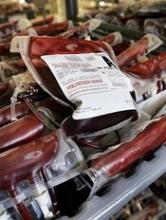BOSTON—New research suggests enzymes from the human gut can turn type A blood into type O more efficiently than previously studied enzymes.
Researchers found this new family of enzymes—whose name has not been made public—can remove the A antigens from red blood cells (RBCs), thereby converting type A blood to O.
Stephen Withers, PhD, of the University of British Columbia in Vancouver, Canada, presented details on the enzymes at the 256th National Meeting & Exposition of the American Chemical Society (abstract CARB105).
A metagenomics approach
Dr. Withers said researchers have been studying the use of enzymes to modify blood as far back as 1982. However, it has been difficult to identify efficient, selective enzymes that are also safe and economical.
To assess potential enzyme candidates quickly, Dr. Withers and his colleagues used metagenomics.
“With metagenomics, you take all of the organisms from an environment and extract the sum total DNA of those organisms all mixed up together,” Dr. Withers explained.
Casting such a wide net allowed the researchers to sample the genes of millions of microorganisms without the need for individual cultures. The researchers then used E. coli to select for genes that code for enzymes that can cleave sugar residues.
“This is a way of getting that genetic information out of the environment and into the laboratory setting and then screening for the activity we are interested in,” Dr. Withers said.
Focusing on the gut
Dr. Withers and his colleagues had considered sampling DNA from mosquitoes and leeches, the types of organisms that degrade blood, but the researchers ultimately found successful candidate enzymes in the human gut microbiome.
Glycosylated proteins called mucins line the gut wall, providing sugars that serve as attachment points for gut bacteria while also feeding them as they assist in digestion. Some of the mucin sugars are similar in structure to the antigens on RBCs in type A and B blood.
Dr. Withers and his colleagues studied the enzymes the bacteria use to pluck the sugars off mucin and identified a family of enzymes that could convert type A blood to type O.
The name of this enzyme family has not been released to the public, as the patent for the enzymes has not been submitted.
“By homing in on the bacteria feeding on those sugars, we isolated the enzymes the bacteria use to pluck off the sugar molecules,” Dr. Withers explained. “We then produced quantities of those enzymes through cloning and found that they were capable of performing a similar action on blood antigens.”
The enzymes could convert type A blood to type O by removing N-Acetyl galactosamine from the surface of RBCs.
In fact, the new enzymes were 30 times more effective for converting A to O than the alpha-N-acetylgalactosaminidase from Elizabethkingia meningospeticum that was described in a 2007 Nature Biotechnology paper.
Dr. Withers said he and his colleagues needed to use 30 times less of the new enzymes. This means the new enzymes are more economical, and it is easier to remove all traces of the added enzymes, which would need to be done before transfusion.
Looking ahead
Dr. Withers noted that the new enzymes work in whole blood. So if they prove safe for use in humans, the enzymes could potentially be introduced to whole blood donations and left to make the conversion from A to O. Then, the enzymes could be removed by washing RBCs before transfusion.
Dr. Withers and his colleagues are now working to validate these enzymes and test them on a larger scale for potential clinical testing. He also plans to carry out directed evolution, a protein engineering technique that simulates natural evolution, with the goal of creating the most efficient sugar-removing enzyme.
“I am optimistic that we have a very interesting candidate to adjust donated blood to a common type,” Dr. Withers said. “Of course, it will have to go through lots of clinical trials to make sure that it doesn’t have any adverse consequences, but it is looking very promising.”
The researchers acknowledged support and funding from the Canadian Institutes of Health Research.


